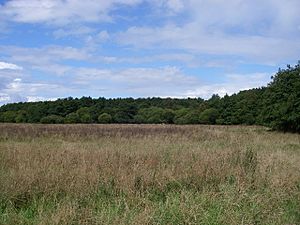Cranberry Rough, Hockham facts for kids
| Site of Special Scientific Interest | |
 |
|
| Area of Search | Norfolk |
|---|---|
| Interest | Biological Geological |
| Area | 81.1 hectares (200 acres) |
| Notification | 1984 |
| Location map | Magic Map |
Cranberry Rough is a very special nature spot in Norfolk, England. It covers about 81 hectares (that's like 200 football fields!). This area is protected because it has important plants, animals, and interesting geology. It's officially called a Site of Special Scientific Interest, or SSSI for short.
Cranberry Rough is also part of the Breckland Special Protection Area. This means it's extra important for protecting wild birds. A fun walking path called the Great Eastern Pingo Trail even goes right through it!
Contents
What Makes Cranberry Rough Special?
Cranberry Rough is important for two main reasons: its amazing wildlife and its unique geology. It's a great place to learn about nature and how our planet has changed over time.
A Home for Wildlife
This area is a mix of different habitats. You can find swampy woodlands, open grasslands, and tall fen areas. There are also many ditches and pools filled with water.
These different habitats mean lots of different plants and insects can live here. You might spot many types of butterflies, dragonflies, and damselflies. Large parts of Cranberry Rough are covered in spongy sphagnum mosses. These mosses help create the wet, boggy conditions that many unique plants love.
A Look Back in Time
Long ago, Cranberry Rough was actually a lake called Hockham Mere. But by the mid-1700s, the lake was drained and dried up.
The ground here holds clues about the past. Scientists can study the soil and find tiny bits of ancient pollen. This "pollen record" tells them what plants grew here thousands of years ago. It helps us understand how the environment has changed since the last Ice Age.
Visiting Cranberry Rough
If you enjoy nature walks, the Great Eastern Pingo Trail is a great way to explore Cranberry Rough. It's a lovely place to see different types of plants and maybe even spot some of the amazing insects that live there. Remember to stay on the paths to protect this special place!

